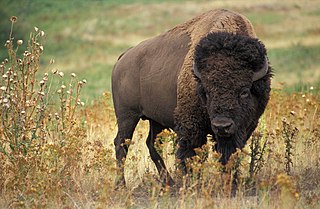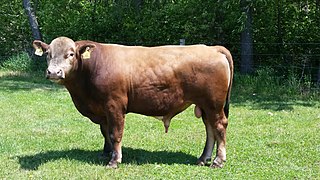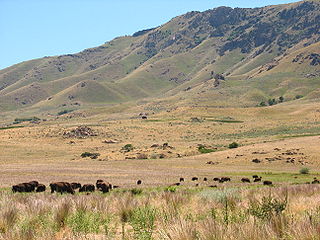Related Research Articles

Bison are large bovines in the genus Bison within the tribe Bovini. Two extant and numerous extinct species are recognised.

The American bison is a species of bison native to North America. Sometimes colloquially referred to as buffalo, it is one of two extant species of bison, alongside the European bison. Its historical range, by 9000 BC, is described as the great bison belt, a tract of rich grassland that ran from Alaska to the Gulf of Mexico, east to the Atlantic Seaboard as far north as New York, south to Georgia and, according to some sources, further south to Florida, with sightings in North Carolina near Buffalo Ford on the Catawba River as late as 1750. Once roaming in vast herds, the species nearly became extinct by a combination of commercial hunting and slaughter in the 19th century and introduction of bovine diseases from domestic cattle. With a population in excess of 60 million in the late 18th century, the species was culled down to just 541 animals by 1889. Recovery efforts expanded in the mid-20th century, with a resurgence to roughly 31,000 wild bison as of March 2019. For many years, the population was primarily found in a few national parks and reserves. Through multiple reintroductions, the species now freely roams wild in several regions in the United States, Canada, and Mexico, with it also being introduced to Yakutia in Russia.

Beefalo constitute a hybrid offspring of domestic cattle, usually a male in managed breeding programs, and the American bison, usually a female in managed breeding programs. The breed was created to combine the characteristics of both animals for beef production.

Tallgrass Prairie National Preserve is a United States National Preserve located in the Flint Hills region of Kansas, north of Strong City. The preserve protects a nationally significant example of the once vast tallgrass prairie ecosystem. Of the 400,000 square miles (1,000,000 km2) of tallgrass prairie that once covered the North American continent, less than 5% remains, primarily in the Flint Hills. Since 2009, the preserve has been home to the Tallgrass Prairie bison herd.

The tallgrass prairie is an ecosystem native to central North America. Historically, natural and anthropogenic fire, as well as grazing by large mammals provided periodic disturbances to these ecosystems, limiting the encroachment of trees, recycling soil nutrients, and facilitating seed dispersal and germination. Prior to widespread use of the steel plow, which enabled large scale conversion to agricultural land use, tallgrass prairies extended throughout the American Midwest and smaller portions of southern central Canada, from the transitional ecotones out of eastern North American forests, west to a climatic threshold based on precipitation and soils, to the southern reaches of the Flint Hills in Oklahoma, to a transition into forest in Manitoba.

The Flint Hills, historically known as Bluestem Pastures or Blue Stem Hills, are a region in eastern Kansas and north-central Oklahoma named for the abundant residual flint eroded from the bedrock that lies near or at the surface. It consists of a band of hills stretching from Kansas to Oklahoma, extending from Marshall and Washington Counties in the north to Cowley County, Kansas and Kay and Osage Counties in Oklahoma in the south, to Geary and Shawnee Counties west to east. Oklahomans generally refer to the same geologic formation as the Osage Hills or "the Osage."

The Midewin National Tallgrass Prairie (MNTP) is a tallgrass prairie reserve and similarly preserved as United States National Grassland operated by the United States Forest Service. The first national tallgrass prairie ever designated in the U.S. and the largest conservation site in the Chicago Wilderness region, it is located on the site of the former Joliet Army Ammunition Plant between the towns of Elwood, Manhattan and Wilmington in northeastern Illinois. Since 2015, it has hosted a conservation herd of American bison to study their interaction with prairie restoration and conservation.

The Joseph H. Williams Tallgrass Prairie Preserve, in Osage County, Oklahoma near Foraker, Oklahoma, is the largest protected tract of tallgrass prairie in the world. Managed by The Nature Conservancy, the preserve contains 39,650 acres (160 km2) owned by the Conservancy and another 6,000 acres (24 km2) leased in what was the original tallgrass region of the Great Plains that stretched from Texas to Manitoba.

The wood bison or mountain bison, is a distinct northern subspecies or ecotype of the American bison. Its original range included much of the boreal forest regions of Alaska, Yukon, western Northwest Territories, northeastern British Columbia, northern Alberta, and northwestern Saskatchewan.

The Plains bison is one of two subspecies/ecotypes of the American bison, the other being the wood bison. A natural population of Plains bison survives in Yellowstone National Park and multiple smaller reintroduced herds of bison in many places in the United States as well as southern portions of the Canadian Prairies.

The shortgrass prairie is an ecosystem located in the Great Plains of North America. The two most dominant grasses in the shortgrass prairie are blue grama and buffalograss, the two less dominant grasses in the prairie are greasegrass and sideoats grama. The prairie was formerly maintained by grazing pressure of American bison, which is the keystone species. Due to its semiarid climate, the shortgrass prairie receives on average less precipitation than that of the tall and mixed grass prairies to the east.

Bison hunting was an activity fundamental to the economy and society of the Plains Indians peoples who inhabited the vast grasslands on the Interior Plains of North America, prior to the animal's near-extinction in the late 19th century following US expansion into the West. Bison hunting was an important spiritual practice and source of material for these groups, especially after the European introduction of the horse in the 16th through 18th centuries enabled new hunting techniques. The species' dramatic decline was the result of habitat loss due to the expansion of ranching and farming in western North America, industrial-scale hunting practiced by non-Indigenous hunters, increased Indigenous hunting pressure due to non-Indigenous demand for bison hides and meat, and cases of deliberate policy by settler governments to destroy the food source of the Indigenous peoples during times of conflict.

The Antelope Island bison herd is a semi–free-ranging population of American bison in Antelope Island State Park in Great Salt Lake, Utah. Bison were introduced to Antelope Island in 1893. The herd is significant because it is one of the largest and oldest publicly owned bison herds in the nation. The Antelope Island bison herd currently numbers between 550 and 700 individuals. Though the bison on Antelope Island are Prairie bison, which was the most common bison subspecies in North America, the bison have a distinct genetic heritage from many of the other bison herds in the United States and they are considered to be desirable as part of the breeding and foundation stock for other bison herds, because of their separate genetic heritage and some of the distinct genetic markers that are found in the population.

The Yellowstone Park bison herd is a bison herd in Yellowstone National Park. It is probably the oldest and largest public bison herd in the United States, estimated in 2020 to be 4,800 bison. The bison in the Yellowstone Park bison herd are American bison of the Plains bison subspecies. Yellowstone National Park may be the only location in the United States where free-ranging bison were never extirpated, since they continued to exist in the wild and were not reintroduced.
The Henry Mountains bison herd, numbering 250 to 400 bison, is one of only four free-roaming and genetically-pure herds on public lands in North America. The other three herds are the Yellowstone Park bison herd which was the ancestral herd for the Henry Mountains animals, the Wind Cave bison herd in South Dakota and the herd on Elk Island in Alberta, Canada.

The Wind Cave bison herd is a herd of 250–400 American bison in Wind Cave National Park, South Dakota, United States. As an active participant in the conservation of American bison, it is believed to be one of only seven free-roaming and genetically pure herds on public lands in North America. The other six herds are in Yellowstone Park, Theodore Roosevelt National Park, Henry Mountains, Blue Mounds State Park (Minnesota), Minneopa State Park (Minnesota), and Elk Island National Park. The Wind Cave herd are of the Plains bison subspecies.

The Niobrara Valley Preserve is a 56,000 acre conservation area in Brown and Keya Paha counties of Nebraska owned by The Nature Conservancy.

American Prairie is a prairie-based nature reserve in northeastern Montana being developed as a private project of the American Prairie Foundation (APF). This independent non-profit organization is creating a wildlife conservation area that aims to cover over 3 million acres (12,000 km2) through a combination of both private and public lands to establish a mixed grass prairie ecosystem with migration corridors and native wildlife.
The Wolakota Buffalo Range is a nearly 28,000-acre native grassland (11,000 ha) for a bison herd on the Rosebud Indian Reservation in South Dakota, home of the federally recognized Sicangu Oyate – also known as Sicangu Lakota, and the Rosebud Sioux Tribe, a branch of the Lakota people. The Rosebud Economic Development Corporation (REDCO), the economic arm of the Rosebud Sioux Tribe, is managing the land. Established in 2020, the herd will help develop ecological restoration, cultural practices, economic development, food security and public education. Wolakota involves public and private partners coming together in support of native-led efforts. Bison is the correct taxonomic term but buffalo is the common vernacular term. Buffalo continues to hold a lot of cultural significance, particularly for Indigenous people and is commonly used.
The conservation of bison in North America is an ongoing, diverse effort to bring American bison back from the brink of extinction. Plains bison, a subspecies, are a keystone species in the North American Great Plains. Bison are a species of conservation concern in part because they suffered a severe population bottleneck at the end of the 19th century. The near decimation of the species during the 1800s unraveled fundamental ties between bison, grassland ecosystems, and indigenous peoples’ cultures and livelihoods.# English speakers used the word buffalo for this animal when they arrived. Bison was used as the scientific term to distinguish them from the true buffalo. Buffalo is commonly used as it continues to hold cultural significance, particularly for Indigenous people. Recovery began in the late 1800s with a handful of individuals independently saving the last surviving bison.# Dedicated restoration efforts in the 1900s bolstered bison numbers though they still exist in mostly small and isolated populations. Expansion of the understanding of bison ecology and management is ongoing. The contemporary widespread, collaborative effort includes attention to heritage genetics and minimal cattle introgression.#
References
- 1 2 "Bison Bellows: Tallgrass Prairie National Preserve". U.S. National Park Service. May 19, 2016. Retrieved March 12, 2022.
- ↑ "Tallgrass Prairie National Preserve Bison Update" (PDF). The Nature Conservancy. January 2012. Archived from the original (PDF) on December 27, 2013. Retrieved December 27, 2013.
- 1 2 3 Biles, Jan (December 7, 2013). "Bison herd at prairie preserve steadily increasing". The Topeka Capital-Journal. Retrieved September 22, 2020.
- ↑ Lawhorn, Chad (October 23, 2013). "Tallgrass Prairie National Preserve conducts first roundup of growing bison herd". LJWorld.com. Lawrence Journal-World. Retrieved March 12, 2022.
- ↑ McGinn, Miyo (September 2, 2022). "Bison are bringing biodiversity back to Kansas prairie land". Popular Science. Retrieved September 6, 2022.
- ↑ Repanshek, Kurt (May 7, 2020). "Interior Department Extends Bison Conservation Initiative For A Decade". National Parks Traveler. Retrieved July 27, 2021.
- ↑ "Mother's Day Delivery at Tallgrass Prairie National Preserve" (PDF) (Press release). National Park Service. May 11, 2010. Archived from the original (PDF) on February 27, 2012. Retrieved December 27, 2013.
- ↑ "Archived copy" (PDF). Archived from the original (PDF) on February 27, 2012. Retrieved December 27, 2013.
{{cite web}}: CS1 maint: archived copy as title (link) - ↑ "Archived copy" (PDF). Archived from the original (PDF) on December 27, 2013. Retrieved December 27, 2013.
{{cite web}}: CS1 maint: archived copy as title (link) - ↑ Smith, Mitch (March 12, 2022). "He Spent Decades Protecting Buffalo. A Microscopic Invader Threatens That Work". The New York Times. ISSN 0362-4331 . Retrieved March 12, 2022.